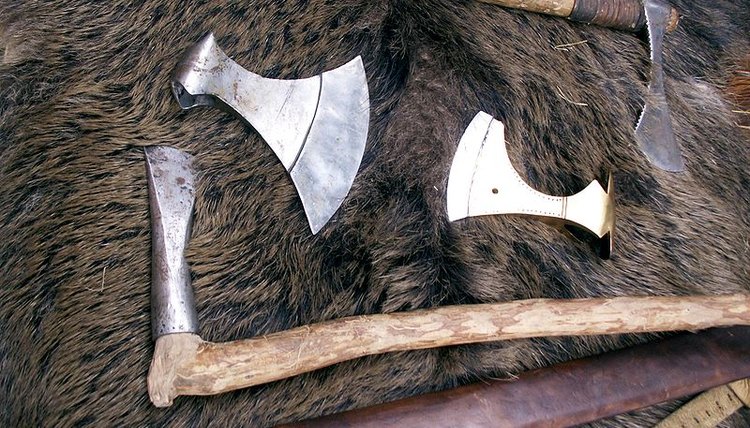Axe Fighting Techniques

Though developed as an agricultural tool by many peoples around the world, the axe was cultivated as a weapon by only a handful of cultures. Chief among these was the Neolithic group of axe-wielders who belonged to what is known as the Corded Ware culture, which would eventually grow into the Nordic Viking tribes. These warriors elongated the blade of the axe and designed it to withstand heavy blows, and thus the battle-axe gradually appeared on European battlegrounds as a fierce and deadly weapon. Now the axe remains as a mainstay in many martial arts traditions.
Specialization
Decide which type of axe you want to specialize in and buy it. The modern martial artist has a variety of axes and fighting styles to choose from, including Nordic Berserker hand-axes, the medieval poleaxe and halberd and the broad-blade axe styles of Jow-Ga Kung Fu. The most commonly practiced of these traditions is the Nordic or Viking battle-axe.
Beginning Techniques
Train yourself in the basic cuts, blocks and postures of axe fighting. Strikes progress from basic over-head, out-side and inside cuts. Blocks are designed to defend the same target areas, while emphasizing trapping your opponent’s weapon. To practice these techniques, stand with your feet shoulder-width apart, with one foot in front of the other. Using one axe in your dominant hand, cut the area in front of you while visualizing someone of your height and build before you. Once you feel comfortable with basic over-head and side cuts, practice stopping your attack at the end of each swing. This will train you to keep your blade straight as you cut and not waver side to side.
Dual-Wield Techniques
When capable of initiating a series of strikes and blocks safely and securely, begin training with an axe in your other hand. Continue practicing basic strikes, blocks and postures. Practice your footwork and become comfortable with advancing and retreating. Familiarize your body with the weight and presence of the axe.
Combat and Sparring
Find a partner with whom you can practice sparring. Communicate clearly what the other person’s action will be: whether in offensive motion or defensive. Use a foam axe, such as any number of the hard foam weapons available online. Keep in mind that even without a sharpened blade, an axe is a deadly weapon, and should never be used against another person with any sort of force. While sparring with your partner, emphasize the axe’s ability to “capture” and redirect your opponent’s weapon, as your off-hand axe goes in for an attack. Be innovative with your training and include other weapons such as foam or wooden swords or bo staffs to better develop your technique against non-axe combatants.
Advanced Techniques
Study your axe’s ability to redirect your opponent’s strike. For instance, when a combatant wielding a sword strikes at you, the off-hand axe will be able to “hook” the sword blade down and out of the way while your main-hand axe strikes for the neck. When fighting another axe-wielder, your best target will be the shaft of his axe; similar to the blade of the sword in the previous example, it can be disarmed from your opponent's grip and moved aside by your off-hand axe as you step in with a powerful attack. As in any fighting art, the possibilities are endless, and an axe fighter is limited only by the scope of his imagination. Remain diligent with your practice and creative with your fighting.
Writer Bio
Based in the Appalachian Mountains, Brian Connolly is a certified nutritionist and has been writing professionally since 2000. He is a licensed yoga and martial arts instructor whose work regularly appears in “Metabolism,” “Verve” and publications throughout the East Coast. Connolly holds advanced degrees from the University of North Carolina, Asheville and the University of Virginia.
